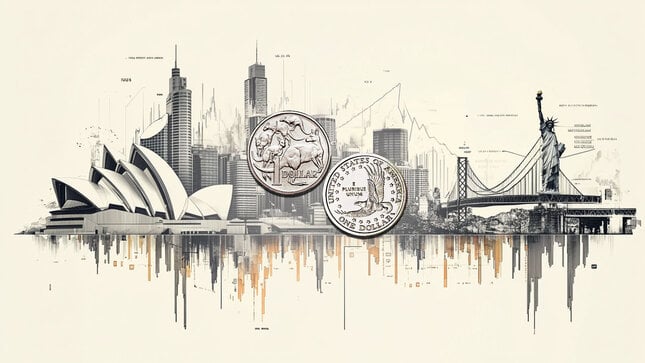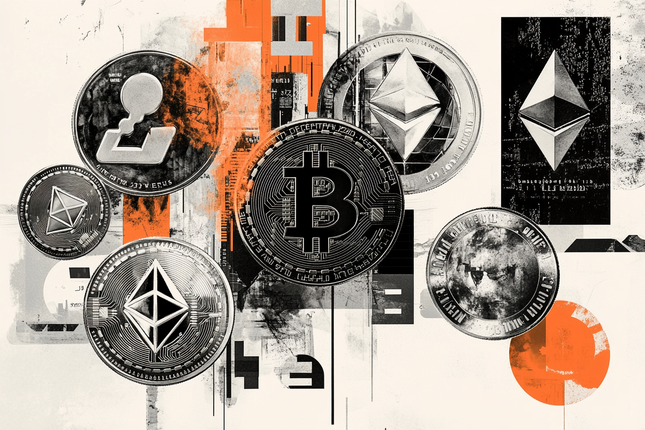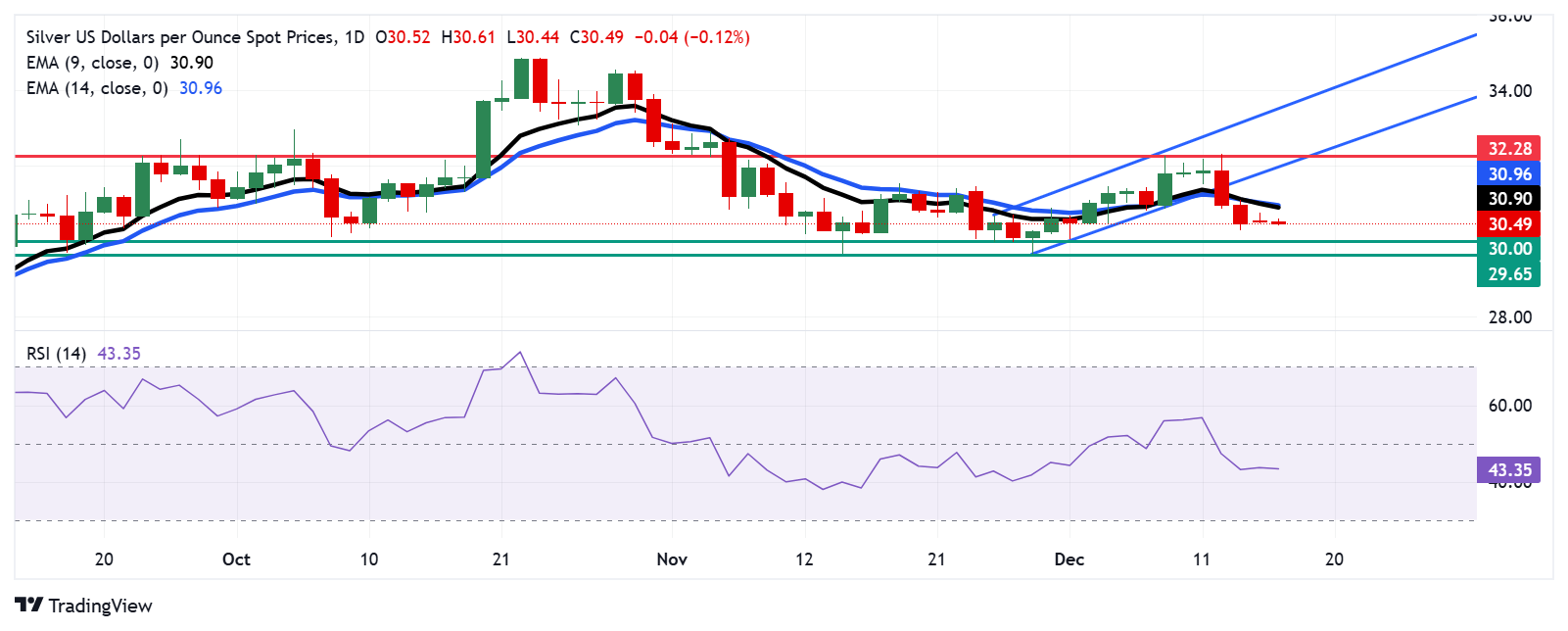- Silver price extends its losing streak as short-term price momentum weakens.
- The alignment of the nine- and 14-day EMAs suggests a lack of strong directional momentum.
- The initial support appears at a psychological $30.00 level, followed by a “throwback support” at its three-month low of $29.65.
Silver price (XAG/USD) continues its losing streak for the fourth successive day, trading around $30.50 per troy ounce during the Asian hours on Tuesday. Analysis of the daily chart indicates a momentum shift to bearish from bullish bias as the pair has broken below the ascending channel pattern.
The XAG/USD pair moves below both of these EMAs, indicating a bearish outlook and signaling to weakening short-term price momentum. This points to increasing selling interest and raises the likelihood of further price depreciation. Additionally, the 14-day Relative Strength Index (RSI) is positioned below the 50 mark, further confirming the emergence of the bearish bias.
However, the alignment of the nine- and 14-day Exponential Moving Averages (EMAs) suggests that the market is experiencing a period of consolidation, lacking a strong directional momentum. Traders may interpret this as a signal that the market is waiting for a catalyst to determine its next move, whether upward or downward.
The XAG/USD pair may test its primary support at the psychological level of $30.00, followed by a “throwback support” level at its three-month low of $29.65, which was recorded on November 28.
On the upside, the immediate barriers appear at the nine- and 14-day EMAs at $30.91 and $30.96, respectively. A break above these levels could cause the bullish bias to re-emerge and help the Silver price to retest its six-week high of $32.28, reached on December 9.
XAG/USD: Daily Chart
Silver FAQs
Silver is a precious metal highly traded among investors. It has been historically used as a store of value and a medium of exchange. Although less popular than Gold, traders may turn to Silver to diversify their investment portfolio, for its intrinsic value or as a potential hedge during high-inflation periods. Investors can buy physical Silver, in coins or in bars, or trade it through vehicles such as Exchange Traded Funds, which track its price on international markets.
Silver prices can move due to a wide range of factors. Geopolitical instability or fears of a deep recession can make Silver price escalate due to its safe-haven status, although to a lesser extent than Gold's. As a yieldless asset, Silver tends to rise with lower interest rates. Its moves also depend on how the US Dollar (USD) behaves as the asset is priced in dollars (XAG/USD). A strong Dollar tends to keep the price of Silver at bay, whereas a weaker Dollar is likely to propel prices up. Other factors such as investment demand, mining supply – Silver is much more abundant than Gold – and recycling rates can also affect prices.
Silver is widely used in industry, particularly in sectors such as electronics or solar energy, as it has one of the highest electric conductivity of all metals – more than Copper and Gold. A surge in demand can increase prices, while a decline tends to lower them. Dynamics in the US, Chinese and Indian economies can also contribute to price swings: for the US and particularly China, their big industrial sectors use Silver in various processes; in India, consumers’ demand for the precious metal for jewellery also plays a key role in setting prices.
Silver prices tend to follow Gold's moves. When Gold prices rise, Silver typically follows suit, as their status as safe-haven assets is similar. The Gold/Silver ratio, which shows the number of ounces of Silver needed to equal the value of one ounce of Gold, may help to determine the relative valuation between both metals. Some investors may consider a high ratio as an indicator that Silver is undervalued, or Gold is overvalued. On the contrary, a low ratio might suggest that Gold is undervalued relative to Silver.
Information on these pages contains forward-looking statements that involve risks and uncertainties. Markets and instruments profiled on this page are for informational purposes only and should not in any way come across as a recommendation to buy or sell in these assets. You should do your own thorough research before making any investment decisions. FXStreet does not in any way guarantee that this information is free from mistakes, errors, or material misstatements. It also does not guarantee that this information is of a timely nature. Investing in Open Markets involves a great deal of risk, including the loss of all or a portion of your investment, as well as emotional distress. All risks, losses and costs associated with investing, including total loss of principal, are your responsibility. The views and opinions expressed in this article are those of the authors and do not necessarily reflect the official policy or position of FXStreet nor its advertisers. The author will not be held responsible for information that is found at the end of links posted on this page.
If not otherwise explicitly mentioned in the body of the article, at the time of writing, the author has no position in any stock mentioned in this article and no business relationship with any company mentioned. The author has not received compensation for writing this article, other than from FXStreet.
FXStreet and the author do not provide personalized recommendations. The author makes no representations as to the accuracy, completeness, or suitability of this information. FXStreet and the author will not be liable for any errors, omissions or any losses, injuries or damages arising from this information and its display or use. Errors and omissions excepted.
The author and FXStreet are not registered investment advisors and nothing in this article is intended to be investment advice.
Recommended content
Editors’ Picks

AUD/USD consolidates gains near 0.6400; remains close to YTD top
AUD/USD holds gains near the 0.6400 mark early Friday and remains well within striking distance of the YTD peak touched earlier this week. A positive risk tone and a potential for a de-escalation in the US-China trade war act as a tailwind for the Aussie but fresh US Dollar byuing could check the pair's upside.

USD/JPY rises above 143.00 amid hot Tokyo CPI print
USD/JPY attracts some dip-buyers adn retakes 143.00 following Thursday's pullback from a two-week high as hopes for an eventual US-China trade deal tempers demand for the JPY. Data released this Friday showed that core inflation in Tokyo accelerated sharply in April, bolstering bets for more rate hikes by the BoJ.

Gold eyes US-China trade talks and third straight weekly gain
Gold price holds Thursday’s rebound, defending weekly gains near $3,350 early Friday. Gold buyers catch a breather, taking stock of the trade developments globally after US President Donald Trump’s tariffs whiplash.

Bitcoin, Ethereum and Ripple to consolidate strong weekly gains
Bitcoin price stabilizes around $93,000 on Friday, following a 9.5% rally so far this week. Ethereum and Ripple followed BTC’s move and rallied by 10% and 5%, respectively. However, these coins exhibit signs of bullish exhaustion on their momentum indicators.

Five fundamentals for the week: Traders confront the trade war, important surveys, key Fed speech Premium
Will the US strike a trade deal with Japan? That would be positive progress. However, recent developments are not that positive, and there's only one certainty: headlines will dominate markets. Fresh US economic data is also of interest.

The Best brokers to trade EUR/USD
SPONSORED Discover the top brokers for trading EUR/USD in 2025. Our list features brokers with competitive spreads, fast execution, and powerful platforms. Whether you're a beginner or an expert, find the right partner to navigate the dynamic Forex market.



